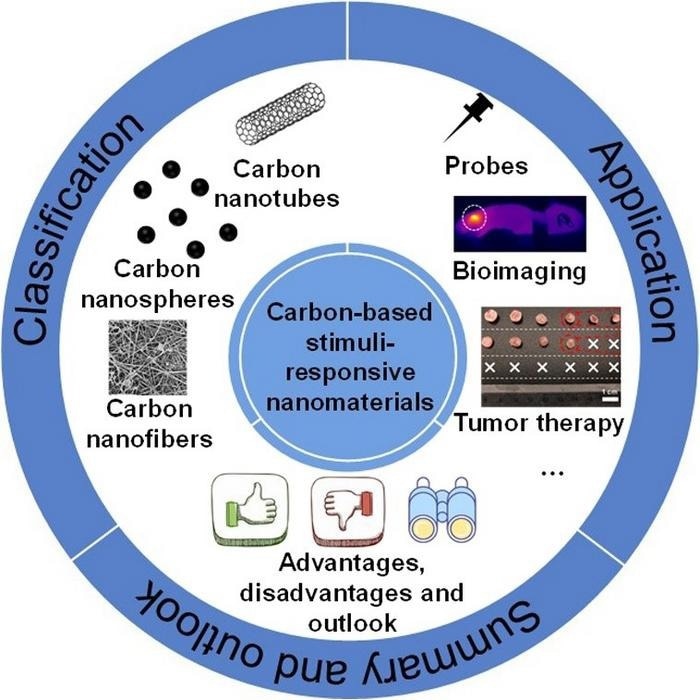Due to their flexibility, including their use in the detection and treatment of diseases, carbon-based stimuli-responsive nanomaterials are attracting a lot of interest. They function in response to extrinsic (temperature, light, magnetic field, ultrasound), as well as endogenous (pH, temperature, enzyme, and redox) stimuli.

Classification, application, summary, and outlook of carbon-based stimuli-responsive nanomaterials. Image Credit: Cyborg and Bionic Systems
As smart materials with dynamically adjustable physicochemical characteristics in reaction to changes in internal or external environmental stimuli, carbon-based stimuli-responsive nanomaterials can be employed.
They provide fresh possibilities for the creation of cutting-edge smart nanomaterials due to the variety of nanostructures and molecular designs they combine, as well as functional complexes with various carriers.
Based on their microstructures and physical characteristics, a research team from the Beijing Institute of Technology reviews the classification and use of carbon-based stimuli-responsive nanomaterials.
They also go over the uses of these materials in bioimaging, tumor therapy, and other fields. Finally, they discuss the benefits and drawbacks of carbon-based stimuli-responsive nanomaterials, summarize them, and predict the future prospects for their application.
Their recommendations were published in Cyborg and Bionic Systems on March 9th, 2023.
Carbon nanotubes, carbon nanospheres, and carbon nanofibers are the three primary groups into which the authors divide carbon-based nanomaterials.
Several carbon-based stimuli-responsive nanomaterials used in advanced scientific and engineering research are listed at the same time, and more nuanced variations are seen in the synthesis and preparation techniques of distinct carbon nanomaterials.
The applications of carbon-based stimuli-responsive materials in the fields of probes, bioimaging, and tumor treatment are then listed by the authors. Due to their distinctive optical characteristics, carbon-based nanomaterials are employed in optical imaging and anti-counterfeiting applications.
The sensitivity of carbon-based nanomaterials can be increased by conjugation with various specific detection reagents. Additionally, carbon-based nanomaterials can be utilized as therapeutic agents (photothermal, photodynamic, chemotherapy, etc.) or drug delivery systems for the treatment of diseases.
Finally, the authors explore the future outlook and the constraints of the development of carbon-based stimuli-responsive materials. In addition to having outstanding physical and chemical characteristics, carbon-based stimuli-responsive materials can be functionalized by combining them with other polymers, making them effective drug delivery and cancer treatment carriers.
Since significant data from clinical tests in medical treatments are currently lacking, it is uncertain how safe carbon-based stimuli-responsive materials are. Research on toxicity, pathology, and biodynamics must be done in-depth to better diminish the debate around carbon-based stimuli-responsive materials and increase reliability.
The study examines the current flaws and potential improvements for carbon-based stimuli-responsive materials, and it also addresses how they are classified and used in biology and chemistry. In general, multiple studies have demonstrated that the hybridization of carbon-based stimuli-responsive materials plays a significant role in the biomedical field.
However, it is vital to do an in-depth study on toxicology and pathology to better lessen the dispute around them and enhance their credibility. Future research is anticipated to increase the security of carbon-based stimuli-responsive materials and make them more advantageous to human life by creating new synthetic methods or composite materials.
Journal Reference
Zhao, C., et al. (2023) Carbon-Based Stimuli-Responsive Nanomaterials: Classification and Application. Cyborg and Bionic Systems. doi:10.34133/cbsystems.0022